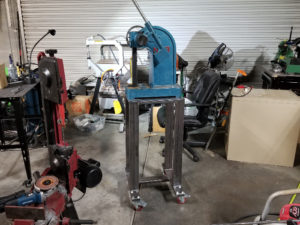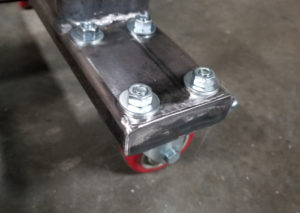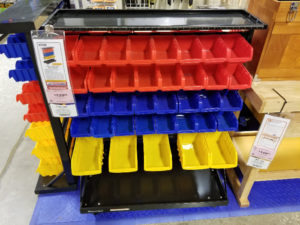Pressing Need Met
January 22nd, 2020More Shop Floor Space Liberated
I had a splendid workshop session today.
If memory serves, and it may well not, I started building an arbor press stand in November. I have a cheesy Asian arbor press, and the first stand I built for it was pretty bad, so I wanted something better. I threw the old stand out. This left me with a heavy iron object sitting on the workshop floor where it was always in the way. The shop is incredibly cluttered right now, and I needed to get wheels on the press so I could roll it around while I arranged things, so I have been working hard to get the stand together.
The press was pretty much welded together last year, but I wasn’t happy. There was some slight warpage on the bottom. I had already made one warped stand, and I didn’t want another one. I took the new stand apart, added bracing, added some weld beads to pull the warps out, and put it back together. It’s still very slightly warped, but supposedly, nearly every welded object is warped, so I don’t feel bad.
Once the structural welding was done, I wanted to spend some time on aesthetics. The stand is made from rectangular tubing, and the ends of the tubes were open. I didn’t like that. It creates places where critters can live, and it looks unfinished. I bought myself some flat steel bar, cut it in pieces, welded it over the ends of the tubes, and ground them to make them look like solid bars. I’ll post a photo.
I guess I put in three hours on that today. I really enjoyed it. It’s fun to take hard, sharp metal and make it look soft and smooth.
As you can see, I haven’t painted the stand. I will probably want to add some features, so it’s a little early to paint. One feature often found on arbor press stands is a bin for catching broaches. A broach is a long cutter than makes rectangular slots in things. An arbor press is the standard tool for broaching. After you push a broach through your workpiece, it falls, so you need some way of preventing it from hitting the floor and being destroyed. I’ve always grabbed it with my hand, but that’s not the preferred method.
I haven’t added a bin yet because it seems to me it will be in the way if I want to use the area under the press for a long workpiece. I want to create a bin that detaches.
I originally planned to have a shelf between the legs of the stand. I may still do that. Alternatively, I might put a couple of bins on the sides, about 4″ wide by 4″ deep by 12″ long.
The original design also called for struts in front to prevent the stand from tipping, but I can’t make it tip the way it is now, so I think I’m going to omit them. A truly foolish person could make it tip, but I don’t plan to invite random people to use the press, so it shouldn’t be a problem.
If I make a bin or a shelf, it will give me a chance to use my SWAG Offroad finger brake. That would be neat. I’ve barely used it, and it’s a great tool. I put an air hydraulic jack on my hydraulic press, and my big compressor is here now, so using the finger brake should be a blast.
I’m very happy to have made the press useful again, but I’m even more happy to have it off the floor. Now I can resume ordering the shop. The mess out there is highly annoying. I bought myself a Harbor Freight bin cart just to get junk out of the way, and I may buy a second Harbor Freight tool cart just for mill and lathe tooling.
The more stuff you put on wheels, the bigger your shop will seem, and the cleaner it will be.
I lifted the press onto the stand without help. Ordinarily, I avoid lifting heavy stuff, but I couldn’t help myself. Every so often, I worry that I’m getting feeble. I decided to see if lifting the press was still a possibility. I have managed to do it during the stand-building process, and I haven’t gone to the ER yet. The press supposedly weighs 135 pounds, so I feel somewhat less feeble than I did before I picked it up. I still want to get a small shop lift, however. It should be easier to resist my silly impulses when I have the correct tool at hand.
I’ve been thinking about adding a new power tool to the shop: a single-lip cutter grinder. This is a machine that will let you sharpen and alter cutting tools such as drill bits and end mills. I didn’t think these grinders were that interesting until I saw that they could be used to make custom cutters. You can take a 1/2″ end mill, cut a slot around it, and turn it into a slot cutter. You can also relieve the shafts of end mills so they don’t rub your work when you make cuts deeper than the flutes are long. Of course, you can also sharpen things, and that’s a big deal, given the cost of carbide end mills.
Single-lip grinders used to be extremely expensive. Then the Chinese got ahold of them. Now you can buy a serviceable Chinese grinder for a fraction of what grinders used to cost. It won’t be a Deckel, but it will do everything a Deckel does. You can also modify it and de-Chinafy it, correcting whatever deficiencies it arrived with.
There are plans out there for making grinders, but the consensus seems to be that these grinders stink. People who have made them defend them, but the truth is that they’ve spent maybe 60% of what a Chinese grinder costs, and they’ve put in maybe 150 hours of work per machine, and they still have grinders others refer to as “fiddly.”
I don’t want fiddly. I want a grinder that works without a lot of who-shot-John.
Of course, if I get a grinder, it will need a stand. Hmm.
Now that the press is on wheels, maybe I can get the shop together.


